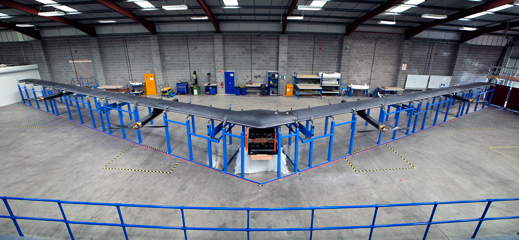Meet Facebook’s Stratospheric Internet Drone
Facebook has built the first of what it hopes will be a large fleet of solar-powered drones to bring Internet connectivity to hundreds of millions of people beyond the reach of today’s telecommunications infrastructure.

Aquila, as the V-shaped carbon fiber craft is known, is powered by two propellers and has a wingspan of about 42 meters, roughly equivalent to a Boeing 737 airliner. When covered in solar panels and loaded with communications gear needed to beam down wireless Internet connectivity, it should weigh only a little over 400 kilograms (about 900 pounds), roughly one-third of a Toyota Prius.
Facebook has not yet flown the recently completed craft but has been testing one-tenth scale versions over the U.K. since March. The full-size Aquila is undergoing structural tests and should begin flight tests before the end of this year.
Jay Parikh, Facebook’s vice president of global engineering and infrastructure, introduced Aquila today at an event at the company’s headquarters in Menlo Park, California. He said that roughly 10 percent of the world’s population, mostly in rural areas, can’t get Internet access with existing delivery technologies. Facebook’s drones will change that, he said: “Our mission in the company is to connect everybody in the world.”
Aquila is designed to be hauled up into the stratosphere by a helium balloon, where it cut loose and will fly in five-kilometer circles at altitudes of between 18 and 27 kilometers (60,000 to 90,000 feet), far above commercial flights, clouds, and weather.
Each Aquila drone will carry radio equipment to provide broadband connectivity to satellite receivers inside a roughly 50-mile radius on the ground below. The drones will also carry equipment that can form high-speed connections using laser beams. The idea is that Facebook will create aerial chains with the drones to link several rural areas to the Internet. The drone nearest an urban area would use its laser to hook into the global Internet, and that connectivity would be passed down the line to drones over rural areas using the laser links. In cloudy weather, the ground-to-drone link will be made using radio instead, at some reduction in the data rate.
Facebook says its engineers recently set a new record for the speed at which data can be transferred using lasers, reporting speeds of tens of gigabits per second, which they said was about 10 times better than previous best efforts.
However, Facebook has considerable work to do before its drone scheme catches up with a stratospheric plan from its rival Google. The search and ads company is already testing helium balloons that can deliver wireless broadband to existing mobile handsets (see “10 Breakthrough Technologies 2015: Project Loon”).
After Facebook gets Aquila off the ground it has to work up to flying it in the stratosphere for about three months at a time for it to be a practical way to deliver Internet connectivity, says Parikh. The longest flight so far is only about two weeks, he says.
Facebook is also behind Google when it comes to figuring out a business model for its drones. Facebook may license or sell its drone technology to companies or governments, but such details remain undecided, Parikh said. “We’re not going to operate this stuff ourselves,” he said.
Google, by contrast, will operate its Loon balloons itself and rent access to them to wireless carriers as a way to extend their coverage. By the end of the year Google plans to have balloons providing continuous coverage for people living along a thin band around the Southern Hemisphere. It has also struck a deal with the government of Sri Lanka to blanket the entire island with balloon-borne Internet coverage.
Mike Cassidy, the leader of Google’s balloon project, has argued that balloons will be cheaper and more practical than drones for some time, due to the technical challenges of inventing and operating them.
Facebook has been working on ways to get more people online since 2013 under a project known as Internet.org. Its main activity has been striking deals with wireless carriers in 17 countries around the world to allow people to use certain online services through a special Facebook app without racking up data fees.
Although Facebook’s founder Mark Zuckerberg has spoken of the project as a humanitarian one, it also has clear benefits to his company because more people online means more potential customers (see “Facebook’s Two Faces”). The Internet.org project has also made Facebook a powerful gatekeeper for Internet access in some countries, leading to a backlash from some Internet users, companies, and governments (see “Facebook’s Internet.org Hits Global Flak” and “Indian Companies Turn Against Facebook’s Scheme for Broader Internet Access”).
Keep Reading
Most Popular
Large language models can do jaw-dropping things. But nobody knows exactly why.
And that's a problem. Figuring it out is one of the biggest scientific puzzles of our time and a crucial step towards controlling more powerful future models.
The problem with plug-in hybrids? Their drivers.
Plug-in hybrids are often sold as a transition to EVs, but new data from Europe shows we’re still underestimating the emissions they produce.
How scientists traced a mysterious covid case back to six toilets
When wastewater surveillance turns into a hunt for a single infected individual, the ethics get tricky.
Google DeepMind’s new generative model makes Super Mario–like games from scratch
Genie learns how to control games by watching hours and hours of video. It could help train next-gen robots too.
Stay connected
Get the latest updates from
MIT Technology Review
Discover special offers, top stories, upcoming events, and more.